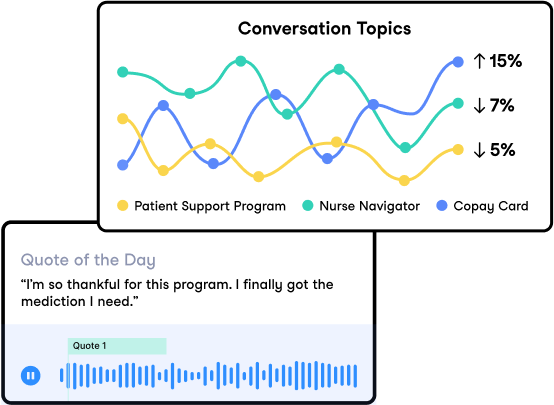Your patients are talking. Are you listening?
Patient experience in healthcare is changing. Leverage data tools to listen at scale to the voice of your patients for informed decision-making and specific solutions.
Learn More
Get actionable patient feedback without survey fatigue or external market research.

CX in pharma that’s immersive and intelligent.
With conversational intelligence technology, Authenticx confidently listens and identifies disruptions impacting customers and contact centers across life sciences.
View Case StudyOver 50,000 patient interactions demonstrate how pervasive disruptions in the healthcare customer journey continue to be.
Patient-Centric Approach Pharma
The patient-centric approach in pharma is a relatively new strategy that places patients at the center of all decisions and activities. This marks a departure from traditional approaches, which have often been more product- or profit-focused with less emphasis on individual patient experiences. By fostering patient-centricity in pharma, numerous benefits can be had by patients, providers, and pharmaceutical companies alike.
For patients, a patient-centric culture ensures that their needs and values are prioritized, leading to more personalized and effective treatment plans. Such an approach can result in better health outcomes, improved quality of life, and increased patient satisfaction. A patient-centric approach also encourages a more collaborative relationship between patients and healthcare providers in which open communication and trust are paramount.
Healthcare providers benefit from adopting a patient-centric approach in several ways. First, by tailoring their services to the specific needs and preferences of patients, providers can enhance the overall efficiency of their practice. This often reduces the likelihood of wasted resources and unnecessary treatments.
The stronger relationships that result from a patient-centric culture can also lead to higher patient satisfaction and improved patient retention, contributing to the long-term success and reputation of healthcare providers. Pharmaceutical companies can also enjoy significant advantages by embracing this approach.
Adopting a patient-centric approach to drug development and marketing is a great way to ensure that products are more closely aligned with the needs of the patient population. This, in turn, can increase product adoption and, ultimately, overall sales. In addition, a patient-centric approach in healthcare can lead to a better understanding of patient needs and insights that can inform future product development.
The patient-centric approach differs from traditional approaches in several ways. It seeks to address the needs and preferences of individual patients rather than focusing solely on the development and promotion of products. This can result in more targeted and effective treatments, as well as improved patient satisfaction and adherence to treatment plans. The approach also promotes the sharing of information and innovation in the development of new therapies.
Finally, a patient-centric approach recognizes the true “patient-centered” meaning, acknowledging that patients are more than just consumers of healthcare products and services, but active participants in their own care. This shift in focus from a purely profit-driven approach to one that prioritizes the well-being of patients can have far-reaching positive impacts on the healthcare ecosystem.
Authenticx’s solution plays a vital role in promoting a patient-centric culture. It allows users to capture and analyze patient voices in order to gain a deeper understanding of their needs and pain points. Using Authenticx, healthcare companies can develop improved strategies for centering patients in their care.
Patient-Centric Meaning
The patient-centric meaning refers to a healthcare philosophy that places the patient at the core of all decisions, activities, and services. This approach focuses on understanding and addressing individual patients’ needs in order to deliver personalized and effective care. In this way, the patient-centric definition encompasses the idea that patients are active participants in their healthcare journey, not just passive recipients of services.
Some patient-centric synonyms include patient-focused, patient-centered, and patient-oriented. These terms all highlight the importance of prioritizing the patient’s perspective and experiences when making healthcare decisions. Additionally, the patient-centric approach meaning and/or patient approach meaning emphasizes the need for healthcare providers, pharmaceutical companies, and other stakeholders to work together to create an environment that fosters patient engagement.
The distinction between patient-centric vs patient-centered can be subtle, as both terms prioritize the patient’s needs and preferences. However, the term “patient-centered” is often used to describe care that is respectful and responsive to individual patient values. “Patient-centric,” by contrast, emphasizes a more holistic view of the patient, including their role in their own care and the broader healthcare ecosystem.
It’s also important to understand physician-centric vs patient-centric care. In a physician-centric model, healthcare providers drive decision-making and care delivery, with the patient’s role being more passive. This can lead to a focus on treating symptoms or diseases rather than addressing the patient’s broader needs and preferences. A patient-centric approach recognizes the importance of the patient’s perspective and actively involves them in decision-making.
As discussed previously, the patient-centric approach to healthcare differs from traditional models in a number of ways. Most importantly, it puts patients at the center of the process and prioritizes all aspects of their care, accounting for their unique needs and desires.
Why is Patient-Centricity Important?
Patient-centricity in the pharmaceutical industry is crucial in ensuring that the development and distribution of drugs and therapies are aligned with the needs and preferences of patients. By focusing on patient-centricity in clinical trials, pharmaceutical companies can develop products that are safe, effective, and tailored to the target population. This approach can result in improved patient outcomes and satisfaction levels across the board.
What is patient-centered care and why is it important? Patient-centered care is an approach to healthcare that focuses on understanding and addressing the needs of each patient rather than treating them as a collective. It involves actively engaging patients in the decision-making process, creating an environment that fosters trust and collaboration between patients and healthcare providers.
But more specifically, why is patient centricity important? Because patient-centricity in healthcare prioritizes patient perspective and experiences, healthcare providers and pharmaceutical companies can provide services that are more aligned with their patients’ needs. This can lead to more personalized care, which is often vital for ensuring long-term positive health outcomes for diverse patient populations.
In short, patient-centric healthcare accounts for the wide range of needs and preferences that exist among patients of various health and demographic backgrounds. Prior to the adoption of this model, profits were often placed above patient well-being. Patients were treated as one large group with the same general needs rather than individuals with unique treatment needs.
By phasing out the provider-centric approach and focusing more on the patient experience, healthcare organizations, and pharmaceutical companies can boost patient satisfaction. This can not only lead to better outcomes for patients but an improved bottom line for businesses.
How It Works
Gain a deeper level understanding of contact center conversations with AI solutions.
See a PreviewAggregate
Pull customer interaction data across vendors, products, and services into a single source of truth.
Analyze
Collect quantitative and qualitative information to understand patterns and uncover opportunities.

Activate
Confidently take action with insights that close the gap between your organization and your customers.
How to Improve Patient-Centered Care
The benefits of patient-centered care have become increasingly evident in recent years as the healthcare industry has moved away from traditional physician-centered models. The patient-centered care definition refers to a model of care that involves patients as active partners in their healthcare decisions. In this model, treatment plans are tailored to their specific requirements for maximum results.
It’s important to understand patient-centered care vs. physician-centered care when considering the best treatment options for patients. In contrast to physician-centered care, where decisions are primarily driven by the clinician’s expertise and knowledge, the patient-centered care theory emphasizes the importance of the patient’s perspective in the decision-making process. This helps foster a more collaborative relationship between the patient and the healthcare provider.
Studies have shown that the impact of patient-centered care on outcomes includes reduced hospital readmission rates and a lower likelihood of experiencing medical errors. Further, patients who receive patient-centered care are more likely to adhere to treatment plans and engage in health-promoting behaviors. These behaviors can ultimately lead to better long-term health outcomes.
One of the primary reasons for these improved outcomes is that patient-centered care facilitates a more open and trusting relationship between patients and their providers. Patient-focused care examples include shared decision-making and tailored patient education materials. Both of these contribute to higher levels of patient satisfaction.
Learning how to improve patient-centered care can enable healthcare organizations to create a more positive patient experience for those they serve. This can benefit everyone involved in the care delivery process.
How to Implement Patient-Centered Care
Developing a patient-centered approach requires a systematic and deliberate shift in healthcare practice and culture. A good example of patient-centered care in nursing, for instance, is a nurse working closely with a patient who has been newly diagnosed with diabetes. The nurse listens to their concerns and works closely with them to develop a specialized treatment plan.
Here are the key steps to consider when implementing patient-centered care in various healthcare settings:
- Train and educate staff: To embrace the patient-centered approach, it is essential to provide adequate training for all healthcare professionals. This should focus on patient-centered care nursing principles, shared decision-making, and cultural competence.
- Foster communication and collaboration: Effective communication is at the heart of patient-centered care. Healthcare providers must engage in open, honest, and respectful conversations with patients, actively listening to their concerns and health goals.
- Implement shared decision-making: In contrast to the traditional medical model, the patient-centered approach emphasizes the importance of involving patients in decisions about their care.
- Personalize care plans: Patient-centered care examples include the development of individualized care plans that take into account patients’ unique circumstances.
- Continuously evaluate and improve: To ensure that patient-centered care remains at the forefront of practice, healthcare organizations must regularly assess the effectiveness of their interventions and make adjustments as needed.
Understanding how to implement patient-centered care, as well as the difference between patient-centered care vs. medical model strategies, is key to delivering better care. By following the aforementioned steps, healthcare providers can ensure quality treatment for patients and improve business outcomes in the process.